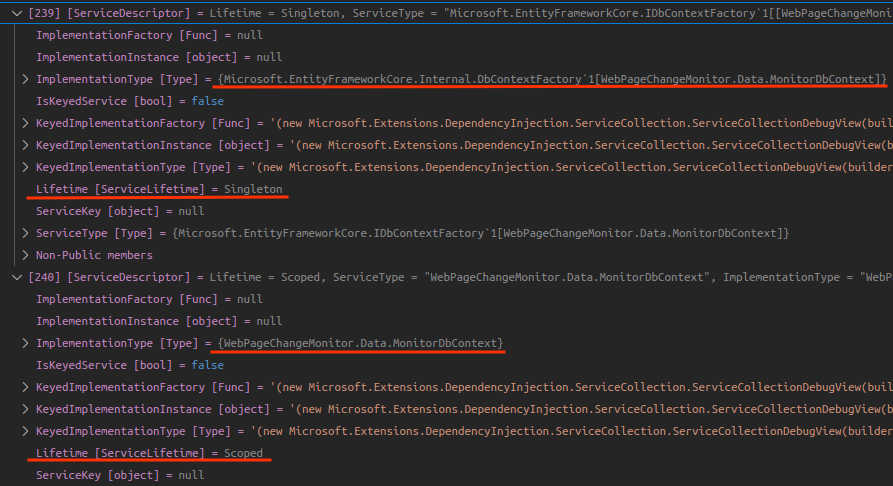Injecting an EF DbContext instance into an IHostedService
Problem
As we all know, there are hardly any APIs that do not use a database to persist their data. ASP.NET makes it easy to connect applications to databases via DbContext, part of Entity Framework.
While working on one of my personal projects, I have encountered the following error when trying to inject DbContext into a hosted background service:
1
Cannot consume scoped service 'Microsoft.EntityFrameworkCore.DbContextOptions' from singleton 'Microsoft.Extensions.Hosting.IHostedService'.
This makes sense since at the time I was using AddDbContext() to register my context, which by default registers a context as scoped. IHostedServices are singletons, hence the conflict.
Solution
To fix the issue, I decided to use AddDbContextFactory() registration instead:
1
2
3
4
5
6
builder.Services.AddDbContextFactory<MonitorDbContext>(options =>
{
options.UseLazyLoadingProxies();
options.UseNpgsql(builder.Configuration.GetConnectionString("ChangeMonitor"));
options.UseSnakeCaseNamingConvention();
});
This method registers a singleton IDbContextFactory and a scoped DbContext which in turn allows us to produce instances of the second on demand via CreateDbContext():
1
2
3
4
5
6
7
8
9
10
11
12
13
14
15
16
17
18
19
20
21
22
23
24
25
26
27
28
29
30
31
32
...
private readonly IDbContextFactory<MonitorDbContext> _contextFactory;
public MonitorJobsRegistrationService(
...
IDbContextFactory<MonitorDbContext> contextFactory)
{
...
_contextFactory = contextFactory;
}
public async Task StartAsync(CancellationToken cancellationToken)
{
await InitiateScheduler(cancellationToken);
using (var context = _contextFactory.CreateDbContext())
{
var targetEntities = await context.Targets.ToListAsync(cancellationToken);
if (targetEntities.Count > 0)
{
_logger.LogInformation("Existing targets found, count: {TargetCount}. Registering jobs...",
targetEntities.Count);
await _jobService.ScheduleAsync(targetEntities.Select(entity => entity.ToTarget()),
cancellationToken);
}
}
}
...
The 2 types registered in WebApplicationBuilder.Services:
 The 2 types registered in WebApplicationBuilder.Services
The 2 types registered in WebApplicationBuilder.Services
The other nice thing about AddDbContextFactory() is that you can still inject scoped DbContext instances directly without using the factory:
1
2
3
4
5
6
7
8
9
10
11
12
13
14
...
private readonly MonitorDbContext _context;
private readonly IMonitorJobService _jobService;
public ResourceService(
MonitorDbContext context,
IMonitorJobService jobService)
{
_context = context;
_jobService = jobService;
}
...
That’s pretty neat. It makes me wonder whether it’s a good idea to just adopt it as a common practice and always use AddDbContextFactory() by default when first wiring up Entity Framework in new projects.
Useful URLs
- https://learn.microsoft.com/en-us/dotnet/api/microsoft.extensions.dependencyinjection.entityframeworkservicecollectionextensions.adddbcontextfactory?view=efcore-9.0
- https://github.com/dotnet/efcore/blob/64512bea5f6f21661ee3a0a99fb9bfa96d44af88/src/EFCore/Extensions/EntityFrameworkServiceCollectionExtensions.cs#L737
- https://github.com/equenum/webpage_change_monitor/blob/d4f6e02f97f77bb0e6ba8abe5b56e0ad70b399ed/api/src/WebPageChangeMonitor.Api/Infrastructure/MonitorJobsRegistrationService.cs
- https://github.com/equenum/webpage_change_monitor/blob/d4f6e02f97f77bb0e6ba8abe5b56e0ad70b399ed/api/src/WebPageChangeMonitor.Api/Services/Controller/ResourceService.cs#L19
- https://github.com/equenum/webpage_change_monitor/blob/d4f6e02f97f77bb0e6ba8abe5b56e0ad70b399ed/api/src/WebPageChangeMonitor.Api/Program.cs#L62
